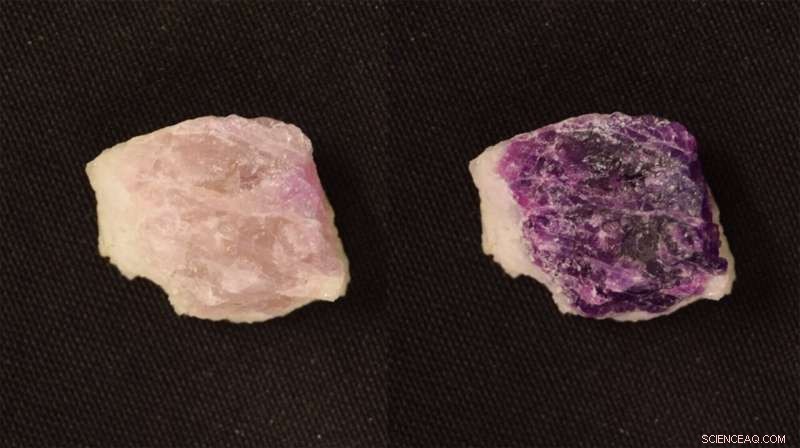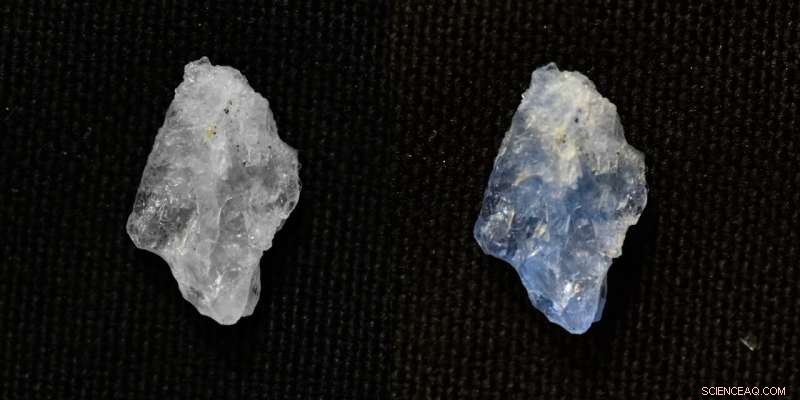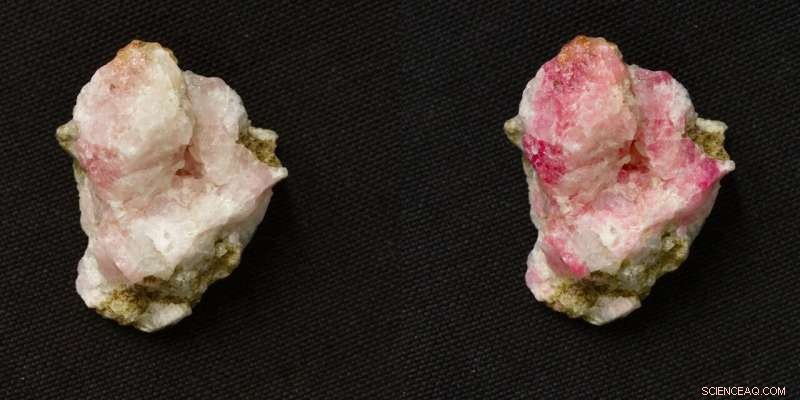
L'hackmanite diventa viola sotto l'irradiazione UV e il colore torna al bianco in pochi minuti sotto la normale luce bianca. Questo campione proviene dalla Groenlandia. Credito:Mika Lastusaari
Durante le indagini sull'hackmanite, i ricercatori hanno scoperto che può cambiare colore dopo l'esposizione alle radiazioni UV ripetutamente senza esaurirsi. I risultati mostrano che l'hackmanite poco costoso, che è facile da sintetizzare, ha anche un'elevata durata e molteplici applicazioni.
Un gruppo di ricerca dell'Università di Turku, in Finlandia, ha studiato e sviluppato le proprietà dell'hackmanite per quasi un decennio. Applicazioni come il monitoraggio UV personale e l'imaging a raggi X sono state sviluppate sulla base della capacità dell'hackmanite di cambiare colore.
Hackmanite cambia colore da bianco a viola sotto l'irradiazione UV e alla fine torna al bianco se non sono presenti UV. Le caratteristiche strutturali che consentono tali cambiamenti ripetuti finora non sono state chiare. Ora, dopo aver studiato tre minerali naturali - hackmanite, tugtupite e scapolite - i ricercatori hanno trovato la risposta.
Questi minerali che cambiano colore sono materiali naturali inorganici, ma ci sono anche composti organici, idrocarburi, che possono cambiare colore in modo reversibile a causa dell'esposizione alle radiazioni. Questi idrocarburi, tuttavia, possono cambiare colore solo poche volte prima che la loro struttura molecolare si rompa. Questo perché il cambiamento di colore comporta un cambiamento drastico nella struttura e subire ripetutamente questo cambiamento alla fine rompe la molecola.
"In questa ricerca, abbiamo scoperto per la prima volta che in realtà c'è anche un cambiamento strutturale coinvolto nel processo di cambio colore. Quando il colore cambia, gli atomi di sodio nella struttura si spostano relativamente lontano dai loro luoghi abituali e poi ritornano Questo può essere chiamato "respirazione strutturale" e non distrugge la struttura anche se viene ripetuto un gran numero di volte", riferisce il professor Mika Lastusaari del Dipartimento di Chimica dell'Università di Turku, in Finlandia.

La scapolite bianca diventa blu sotto l'irradiazione UV. La colorazione e il ritorno al bianco dopo la rimozione della sorgente UV richiedono solo pochi secondi, perché gli atomi nella struttura si muovono per brevi distanze. La scapolite è un minerale piuttosto comune. Questo campione viene dall'Afghanistan. Credito:Sami Vuori
I ricercatori hanno dimostrato che la capacità dell'hackmanite di alternare tra forme bianche e viola è altamente ripetibile
Secondo il professor Lastusaari, la durabilità è dovuta alla forte struttura tridimensionale a gabbia di questi minerali, simile a quella che si trova nelle zeoliti. Nei detersivi, ad esempio, la struttura a gabbia consente alla zeolite di rimuovere magnesio e calcio dall'acqua legandoli saldamente all'interno dei pori della gabbia.
"In these color-changing minerals, all processes associated with the color change occur inside the pores of the zeolitic cage where the sodium and chlorine atoms reside. That is, the cage-like structure allows atomic movement inside the cage while keeping the cage itself intact. This is why minerals can change color and revert back to their original color practically indefinitely," Doctoral Researcher Sami Vuori explains.
Previously, it has been known that scapolite changes color much faster than hackmanite, whereas tugtupite's changes are much slower.
"Based on the results of this work, we found out that the speed of the color change correlates with the distance that the sodium atoms move. These observations are important for future material development, because now we know what is required from the host structure to allow the control and tailoring of the color change properties," says Doctoral Researcher Hannah Byron.
"There were no characterization methods available for the research on color changing minerals, which is why we have developed new methods by ourselves. However, it is difficult to interpret the results unambiguously based on experimental data alone. In fact, we could not have reached the present conclusions without strong support from theoretical calculations, since only the combination of experimental and computational data shows the whole picture. We owe a great many thanks to our collaborator Professor Tangui Le Bahers and his group, who have developed and advanced suitable computational methods to such detail and accuracy that would not have been possible just a few years ago," says Lastusaari.

Tugtupite is a rare mineral, which turns pink when exposed to UV radiation. The return back to white takes several hours, because it requires large atomic movements. This sample is from Greenland. Credit:Sami Vuori
Hackmanite has amazing potential for applications
The Intelligent Materials Research Group at the Department of Chemistry of the University of Turku, led by Lastusaari, has long conducted pioneering research on materials with light and color-related properties, especially on hackmanite. They are currently exploring numerous applications for hackmanite, such as possibly replacing LEDs and other light bulbs with the natural mineral and using it in X-ray imaging.
One of the most interesting avenues that the researchers are currently exploring is a hackmanite-based dosimeter and passive detectors for the International Space Station, intended to be used to measure the radiation dose uptake of materials during space flights.
"The strength of hackmanite's color depends on how much UV radiation it is exposed to, which means that the material can be used, for example, to determine the UV index of Sun's radiation. The hackmanite that will be tested on the space station will be used in a similar fashion, but this property can also be used in everyday applications. We have for example already developed a mobile phone application for measuring UV radiation that can be used by anyone," explains Sami Vuori.
The paper was published in June in the PNAS journal. + Esplora ulteriormente